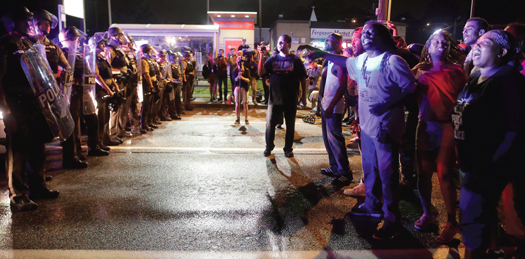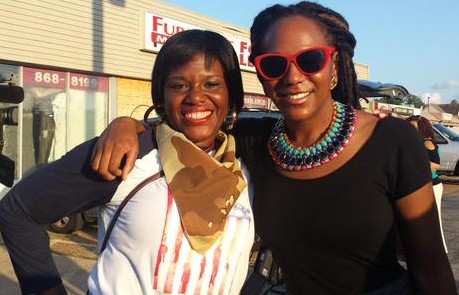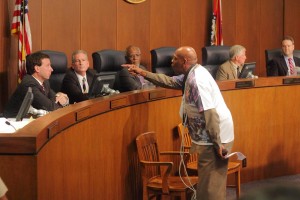Video above: Ferguson shooting of man [Tyrone Harris, Jr.] and arrest of videographer recording crime scene –posted by Photography is not a Crime
Harris family denies he had a gun; why were plainclothes police tailing this friend of Mike Brown’s? Who shot into crowd at store first?
Ferguson 15-year-old says he would fire at police: “I wouldn’t want to do it but I would to save my life.”
 By Richard B. Muhammad and J.A. Salaam –Final Call Staffers
By Richard B. Muhammad and J.A. Salaam –Final Call Staffers
Updated Aug 11, 2015 – 4:41:39 PM
(Photos, captions and videos inserted by Voice of Detroit.)
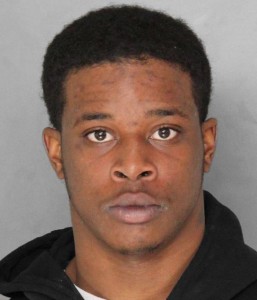
Tyrone Harris Jr. who is fighting for his life. His family denies he was armed; girlfriend who was with him said he was running toward her car, which was parked near plainclothes police car. Police said they had been tailing him all day. Was he targeted by police as friend of Michael Brown? Who started the barrage of shots outside the store–protesters or police? Why were plainclothes police involved in the first place?
FERGUSON, Mo. (FinalCall.com) – The image of a young Black male, bloodied, handcuffed facedown and surrounded by police officers was perhaps the ultimate illustration of how little has changed a year after 18-year-old Mike Brown, Jr., was shot to death here by a White police officer.
A state of emergency was imposed Aug. 10 as Tyrone Harris, Jr., fought for his life at Final Call press time. According to the St. Louis County Police Dept. the 18-year-old was involved in a gunfight with others on West Florissant Avenue, fled his enemies but turned his weapon on plainclothes officers responding to the gunplay.
The emergency declaration did little to keep people off of streets, it initiated a nightly cycle of confrontation well-established a year ago. Aggressive policing, tear gas and what demonstrators see as intimidation only breed a counter refusal to back down or kowtow to authorities.
Some 2,000 protestors showed up the night of Aug. 10 and appeared to outnumber police officers, who remained in full riot gear and quickly moved against anyone who tried to block traffic.
“It’s like the police have learned nothing. The state of emergency is the result of county government’s unwillingness to control the police and authorities, who used excessive force on a crowd that was retreating as instructed,” said Montague Simmons, executive director of the Organization for Black Struggle. “Once again, police disregarded the rules of engagement. (County executive Steve Stenger) has shown no interest in engaging in dialogue or changes.”
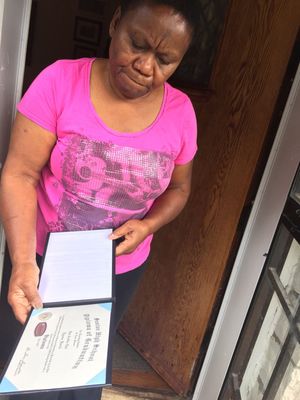
Gwen Drisdel, Tyrone Harris, Jr’s grandmother, shows his high school diploma to St. Louis Post-Dispatch reporter. She told him, “I don’t believe he would disrespect police like that. There was a lot of confusion, and it was very dark. . . .I know his girlfriend said he was running from the shooting toward her car, and where the plainclothesmen were. He was running from the bullets; I’m not even sure he knew he was encountering police.”
“The Organization for Black Struggle supports the pursuit of justice through nonviolent civil disobedience as displayed by Moral Monday sit-in participants today. Based on St. Louis County Commissioner Stenger’s stated criteria for declaring a state of emergency, the St. Louis metro area should always be under a state of emergency because of the constant potential for harm to Black people and relentless attempts to silence those who work toward justice,” Mr. Simmons added.
“In light of last night’s violence and unrest in the City of Ferguson, and the potential for harm to persons and property, I am exercising my authority as county executive to issue a state of emergency, effective immediately,” Mr. Stenger announced referring to 50-60 gunshots that rang out the early morning of Aug. 10. St. Louis County Police Chief Jon Belmar said shots were fired at an unmarked police vehicle and with bullets piercing a window and the front of the SUV.
Mr. Harris, Jr., is accused of firing those shots.
He faces 10 felony charges, five counts of armed criminal action, four counts of first-degree assault on a law enforcement officer and a firearms charge. He was in critical condition after surgery and family members complained they were given no information and were not given a chance to see him.
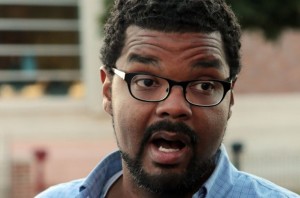
St. Louis Alderman Antonio French. He disparaged looters as opportunists. Dr. Martin Luther King, Jr. said rebellions are “the voice of the unheard.” There have been looters in every major rebellion in the U.S. They are poor people re-distributing the wealth that is not available to them, unlike Alderman French, who evidently has no need to do so–VOD
The shots rang out in the wee hours of Aug. 10 as protestors confronted a line of officers dressed in riot gear across Ferguson Avenue and West Florissant Avenue as officers essentially had protestors surrounded.
“Opportunists,” in the words of Alderman Antonio French of St. Louis, tried to break into some businesses. Shots rang out as he and others tried to prevent any looting.
Malik Shabazz of Black Lawyers for Justice, who was back in town to commemorate the one-year anniversary of the rebellion and killing of Mike Brown, Jr., saw a confrontation between two groups and then heard gunshots. It looked like a dispute as a teenager broke into a store and others tried to take the stolen items, he said.
As Mr. Shabazz ducked for cover, he couldn’t tell who was doing the shooting, but heard something striking the street.
Panic set in as shots were fired. People ran, snatching up baby strollers and children. Others ducked behind cars or any available barrier. Police said shots were also fired on a lot in front of a market. They ordered people away from their lines.
A short time after people cleared out, social media exploded with tweets and photos saying someone had been shot, possibly killed. People returned to the area, angry, frustrated and fed up. There was shouting, some items thrown at police, then smoke bombs and what protestors called tear gas.
The county executive declared enough is enough: “The recent acts of violence will not be tolerated in a community that has worked so tirelessly over the last year to rebuild and become stronger.” He turned law enforcement authority and police emergency management for Ferguson and surrounding areas into the hands of Chief Belmar.
An active and peaceful weekend gave way to angst, protest and civil disobedience as protestors shutdown several highways, were arrested sitting-in at the St. Louis federal building and took to the streets. “Justice Department do your job!” they chanted outside of the federal court building.
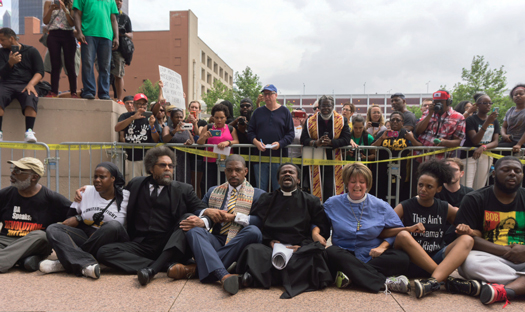
Cornel West (third from l) and others engage in civil disobedience outside federal courthouse in St. Louis. West and others were later arrested. FC photo
Pastor Cori Bush questioned whether the state of emergency was to protect people or property. None of the three people shot last night were mentioned by the county executive, she said. She also saw the declaration as an excuse for officers to escalate conflict.
Things were peaceful when police didn’t come out, then it progressed from talking with officers, to reinforcements quickly filing in, to two tanks, and riot gear wearing officers in an L-shaped formation moving forward, pushing people for no reason, said Pastor Bush. She came out to West Florissant Avenue after hearing someone had been shot.
“All we wanted to know was what was going on,” Pastor Bush said. Some people were maced in the face, mace hit the back of her head and then people went crazy, she said. There had to be 300 officers on the scene, said Pastor Bush.
No peace until police shootings stop
Police and politicians aren’t the only ones who are fed up, said Pastor Bush. “Ferguson will take more of this until they stop shooting us. What do they expect? What day on the calendar can they pinpoint and say ‘we are not going to shoot you?’ We came out here for justice and if we wanted to turn back we would have done it months ago,” said the woman who described herself as “Miss Ferguson Frontline.”
“After a year of protests and conversation around police accountability, having plainclothes officers without cameras or proper identification in the protest setting leaves us with only the officer’s account of the incident, which is problematic,” observed Kayla Reed of the Organization for Black Struggle.
Family members of the accused shooter insisted he did not have a weapon and was trying to get away from shooters when officers fired on him.
“The people are more fed up than the police and the politicians because the politicians have put things in place that is business as usual,” said activist Anthony Shahid, who has been engaged in protests and supporting the father of Mike Brown, Jr. over the past year.
The police are disconnected from Blacks and with “this Darren Wilson mindset are shooting us straight down and our people are tired of it. Young people just are not going to take it,” he said.
He called for four and half days of civil disobedience and shutting down anything and everything—highways, bus stations, convention centers, federal banks, tourist attractions. “I am saying close them down because White folk don’t understand nothing but money,” said Mr. Shahid.
“It’s not going to get better,” he said. They are shooting Black folk like animals but even the animals have more rights than Blacks do, added the activist. Animal rights groups will defend the well-being of animals but no one cares about Black suffering, said Mr. Shahid.
“I don’t see Black police shooting White boys like that,” he continued. So long as cops, politicians, prosecutors and police unions collude to protect all officers, the unrest is not going to die down, Mr. Shahid predicted.
“I see the volcano getting ready to erupt,” he said.
Whether the police version of events on West Florissant Avenue, which was a hotbed for protest and the site of sporadic looting a year ago, holds up or not—there is a deep crisis between the community and officers supposed to protect it.
In an interview outside of the Ferguson Police Department the night of Aug. 8, a 15-year-old shared his fear of police and willingness to fire at officers to protect his life. The teenager from St. Louis is convinced officers would kill in an encounter. “I wouldn’t want to do it but I would to save my life,” he said.
“The ready to die spirit? I don’t think it’s left us at all,” said Johnetta Elzie, 26, who lived in St. Louis but was drawn to the Ferguson protests last year. She made her mark during demonstrations and by overseeing the Ferguson newsletter for protestors with DeRay McKesson.
Three times between last August and September she recalled conversations with the Creator as she faced circumstances that might have been her last days on earth.
Her continued activism has brought visibility, death threats, internet trolls who harass her, people probing for her personal information and reaching out to relatives who she hasn’t talked to for years. “To be a young Black woman and, you know, it’s just me, it is disheartening to know that people are that evil.”
“Since America was founded Blackness has been illegal,” she continued.
She was arrested during Moral Monday protests. She tweeted later: “The same building I testified against the police in last September is the same place I get arrested and manhandled for livestreaming.” “Sitting in that cell with the other women and the white women telling us they didn’t get searched, zip ties weren’t tight,” she continued. “There was little physical or verbal abuse with the white women who participated in the action at the DOJ. US?! Like this shit was violent,” she tweeted.
The “events of last night are a painful reminder that the work for both citizens and local police has only just begun,” wrote Jamilah Lemieux, who was in town to cover the weekend for Ebony magazine. Her piece appeared Aug. 10 on Ebony.com.
“We spent about an hour and a half on West Florissant, live-streaming, talking to people and watching August of 2014 replay itself: mace, smoke and what felt and smelled like teargas; M-16s; a police line, tanks, screaming citizens, people occasionally throwing water bottles and small rocks in the direction of officers—not legal, but not lethal, not an actual threat to someone wearing a helmet and shield.
“As it did last year, this level of response and the haunting visual of militarized-looking police occupying a Midwestern suburb seemed to only escalate the frustration of the crowd—many of whom believed Harris to be dead and were unsure of the circumstances of the shooting. It seems that here in Ferguson, police continue to have something in common with some of the young Black people they have been accused of targeting: the inability to de-escalate conflict peacefully. The difference, of course, being that a hotheaded teenager who has been made to feel by law enforcement and society-at-large that his life lacks value cannot fairly be judged by the same standards as an armed agent of the state.”
Baby steps, tiny steps, meager steps have been taken but nothing to change Ferguson or America, Anthony Shahid said. “If you ask me it’s worse, because since then you’ve had more shootings. The police are just straight shooting people, in their cars, outside of their cars.”
Rating progress over one year
The one-year anniversary of the death of an 18-year-old was a whirlwind of activity and some surface changes. Instead of standing with pepper spray and riot gear, state police handed out popsicles and water outside of a football stadium at Normandy High School, where “Mike Mike” graduated and where his father assembled his family and other families who have lost loved ones to police brutality and what activists call police murder.
Mike Mike’s mother, Lezley McSpadden and her organization, Mothers of the Rainbow, hosted a weekend dinner to kick off her foundation to help mothers who have lost children to violence and work to combat unjust criminal justice system policies.
Zaki Baruti, a longtime activist from St. Louis and leader of the Universal African Peoples Organization, was in the first wave of responders to the “murder of Michael Brown.”
He gave the yearlong pattern of Black resistance an “A” grade, saying a new crop of young leaders is gaining knowledge and pushing the struggle for Black progress.
His analysis was part of the “The Ferguson Report Card: Facing the Future,” an assessment of the year that had passed that was delivered at Greater St. Marks Church in Ferguson.
Points of progress include the removal of police chief Tom Jackson, three Black members of the city council and the firing of a clerk over racist emails. The Justice Dept. also came to Ferguson and documented a pattern of rights abuses and fines used to raise money for the municipality on the backs of Blacks for everything from jaywalking to having grass that was too high.
In Ferguson, traffic fines cannot be more than 12.5 percent of the city budget, while in the past such costs were 30 percent of revenue and targeted Blacks. Other towns in St. Louis County, Mo., face similar limits on revenue generated by traffic fines. There is also no longer jail time for traffic violations, which was part of a cycle of misery for Blacks, who unable to pay fines would end up in jail, lose job and again be unable to pay fine and again face jail.
On the “F” side of the report card, Ferguson’s police department, with a new Black interim chief, remains predominantly White in a predominantly Black city.
“Whatever our population we should have that proportion of power in political office,” said Mr. Baruti. Ferguson is about 70 percent Black.
Then there was the refusal of the governor to remove county prosecutor Bob McCullough, who refused to indict then-officer Wilson, who testified before a grand jury that was given the wrong interpretation about points of law at one time.
Dr. Christi Griffin reported legal successes and failures: A recall petition against Mayor James Knowles of Ferguson failed as the city disqualified some signatures needed on a petition to oust him. In July a suit was filed challenging the striking of the signatures. A civilian review board is under review for Ferguson and St. Louis has approved a citizen review board, which will likely be in operation next April to review police conduct and shootings but will have no subpoena power. St. Louis has cancelled 250 warrants for non-violent traffic offenses.
The ACLU of Missouri has defended first amendment rights of students protesting a speech by Gov. Jay Nixon and defended student protestors disciplined by schools.
The ACLU has also filed a suit on behalf of a grand juror prohibited from speaking to the press for what happened inside the secret proceeding and with prosecutors, but District Attorney Bob McCullough is able to share his views of the grand jury publically. Efforts are still underway to charge Mr. McCullough with misconduct, she added.
The National Bar Association has created guidelines against excessive force to several states, including Missouri, and urged Congress to pass measures to help bring police under control. The Justice Dept. had two civil rights probes of Ferguson over ticketing patterns and constitutional violations of Blacks, but the city rejected a proposed Justice Dept. settlement and will negotiate with the federal government over the concerns, she said.
President Obama put forth a $263 million, two-year spending package for body cameras and police training but the Republican-dominated House rejected the package. And, in Missouri, police body camera recordings are kept secret.
Adolphus Pruitt of the St. Louis NAACP noted there is a cap on how much money the municipalities can keep but not on the amount to be collected. What is collected through fines over the cap has to go to the state for education, he noted. The thinking is that by limiting how much the municipalities can keep will curb abuses but nothing says they can’t stop and fine you as has been done in the past, he noted.
There is a lack of representation and reinvestment in St. Louis County which has more Black people than any other part of the state, he said.
There is also a tremendous violence among Blacks, said the civil rights leader. In over 144 killings, most had drugs in their system, those killed and those arrested for killings were high school drop outs, Mr. Pruitt said. The average age of deaths was 29 and majority were males but females are joining the ranks of victims, he said.
High school drop outs get caught in a black market of drugs and violence and are buried, said Mr. Pruitt. “It’s a trap we have to get rid of,” he said.
About a quarter of St. Louis County is Black, but 44 percent of those in jail as adults are Black and incarcerated parents lead to drop outs and young people stuck on streets, said Mr. Pruitt. Blacks are struck off of juries, rarely hired by fire and police departments, but these entities are paid for by Black tax dollars, he noted. Black children don’t need lawyers, he said, they need to be kept out of the system in the first place.
Poverty and joblessness remain problems in Ferguson, said analysts and community leaders.
Rev. E. Lance McCarthy of Ferguson 1000 Jobs called for a strong focus on economics and training to solve problems that are based on poverty and economics. His group is focused on creating jobs and connecting people to jobs. Twenty-two percent of Blacks live in poverty, 45 percent Black children live in poverty and 36 percent of area youth are unemployed, said presenters. St. Louis is the fifth most segregated city in the country, has low job creation rates and is a leader in crime, they added.
Blacks need to pool their resources and use targeted spending to help solve their own problems, said a presenter, noting McDonalds’ restaurants in poor Black areas make thousands of dollars a month.
“All lives don’t matter, until we make sure that Black Lives Matter,” said Deborah Krause of the Eden Theological Seminary. White churches put up signs saying “Black Lives Matter” and White residents took the signs down, she said. Now the churches are using billboards to proclaim the message but it is a struggle within White churches to utter the phrase “Black Lives Matter” as if saying it devalues White lives, she added.
Maria Chappelle Nadal, a state senator, shared a heartbreaking story: She has literally helped stop three people from committing suicide. People see themselves dying at the hands of the police and they don’t feel there is any hope, she said. “It’s very depressing,” she added.

